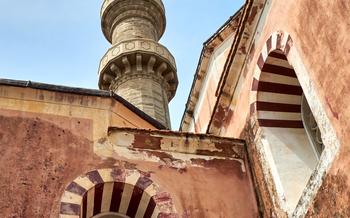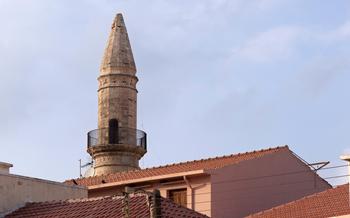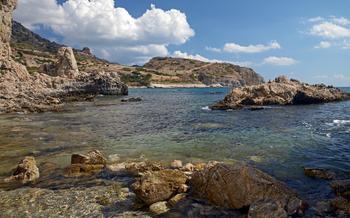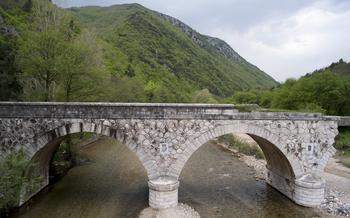
Eski Mosque
- Komotini's Eski Mosque: A Masterpiece of Ottoman Architecture
- Location and Accessibility: Finding Your Way to the Eski Mosque
- Exploring the Mosque's Interior: Unveiling Hidden Treasures
- The Legend of the Mosque's Construction: A Tale of Faith and Perseverance
- The Role of the Eski Mosque in Komotini's Past and Present
- The Evolution of Architectural Styles: From Byzantine to Ottoman
- Experiencing the Call to Prayer: A Sound That Echoes Through History
- Preserving a Cultural Heritage: The Ongoing Restoration of the Eski Mosque
- Unveiling the Secrets of Islamic Architecture: A Deeper Dive
- The Surrounding Neighborhood: Exploring Beyond the Mosque
- A Journey Through Time: Exploring Komotini's Rich History
- Festivals and Celebrations: Komotini's Vibrant Cultural Scene
- Local Delights: Savoring Komotini's Culinary Treasures
- Beyond the Mosque: Discovering More of Komotini's Architectural Wonders
- Insider Tip: Unveiling the Hidden Gem Within the Eski Mosque
Komotini's Eski Mosque: A Masterpiece of Ottoman Architecture
Komotini's Eski Mosque, a testament to the city's rich history and cultural diversity, stands tall as a masterpiece of Ottoman architecture. Built in the 16th century, the mosque holds significant historical and architectural significance, embodying the grandeur and artistry of the Ottoman era. Its unique design and intricate details showcase the fusion of Islamic and Byzantine influences, creating a captivating blend of architectural styles. Beyond its architectural beauty, the Eski Mosque serves as a symbol of religious devotion and cultural heritage, deeply embedded in the fabric of Komotini's identity. Its presence echoes the city's journey through time, reflecting the harmonious coexistence of different cultures and traditions. Visiting this sacred space is not just an architectural exploration but a journey into the heart of Komotini's cultural and spiritual past.
Location and Accessibility: Finding Your Way to the Eski Mosque
The Eski Mosque stands tall and proud in the heart of Komotini, beckoning visitors with its exquisite architecture and historical significance. Located on Vasileos Georgiou Avenue, the mosque is easily accessible from various parts of the city. Whether you prefer the convenience of public transportation or the flexibility of driving, reaching the Eski Mosque is a breeze.
Public Transportation:
For those who prefer to leave the driving to someone else, several public transportation options are available. Hop on bus routes 1, 2, or 3, which conveniently stop near the mosque. These buses connect different parts of the city, making it easy to plan your journey.
Driving:
If you prefer the freedom and convenience of driving, you'll find ample parking options near the mosque. Several designated parking areas are available within walking distance, so you can leave your car behind and explore the mosque and its surroundings on foot.
Nearby Landmarks:
Once you arrive at the Eski Mosque, take a moment to orient yourself with the surrounding landmarks. Just a stone's throw away lies the vibrant Komotini Town Hall, a testament to the city's administrative and civic life. Additionally, the historic Komotini Clock Tower stands tall nearby, inviting you to delve deeper into the city's rich past.
Exploring the Mosque's Interior: Unveiling Hidden Treasures
Stepping inside the Eski Mosque is like embarking on a journey through time and artistry. The mosque's interior is a symphony of intricate details and opulent decorations that captivate the senses. The layout is straightforward, with a central prayer hall flanked by two rows of columns that support the domed ceiling. The ceiling itself is a masterpiece, adorned with colorful paintings and intricate geometric patterns that seem to dance in the soft light filtering through the stained-glass windows.
Among the notable features of the mosque's interior are the mihrab, the minbar, and the dome. The mihrab, a niche in the wall indicating the direction of Mecca, is exquisitely carved with verses from the Quran. The minbar, the pulpit from which the imam delivers sermons, is an ornate work of art, intricately carved with floral motifs and geometric designs. The dome, the crowning glory of the mosque, is adorned with vibrant frescoes depicting scenes from the life of the Prophet Muhammad.
The walls of the mosque are adorned with stunning calligraphy, verses from the Quran, and intricate tilework that showcase the artistic prowess of the mosque's builders. The overall effect is one of awe-inspiring beauty and devotion, creating a serene and sacred space for prayer and reflection.
The Legend of the Mosque's Construction: A Tale of Faith and Perseverance
The construction of Komotini's Eski Mosque is shrouded in a fascinating legend that has been passed down through generations. As the story goes, the mosque's construction faced numerous challenges and obstacles. The initial attempts to build on the chosen site were met with resistance from the local soil, which kept collapsing.
Undeterred, the determined builders sought divine intervention. They turned to a local holy man, who advised them to sacrifice a black bull and mix its blood with the mortar used to construct the foundation. Miraculously, the soil stabilized, and the construction proceeded without further hindrance.
Another version of the legend tells of a mysterious figure who appeared to the builders in a dream, instructing them to seek a hidden treasure buried beneath the chosen site. Upon digging, they discovered a vast amount of gold, which they used to finance the completion of the mosque.
These legends add a layer of mystique to the Eski Mosque, highlighting the deep faith and perseverance of those who built it. They serve as a reminder that even the most challenging endeavors can be overcome with determination and a belief in the divine.
The Role of the Eski Mosque in Komotini's Past and Present
A Center of Faith and Community
Throughout its existence, the Eski Mosque has played a pivotal role in Komotini's religious and cultural landscape. As the city's oldest and most prominent mosque, it has served as a spiritual beacon for the Muslim community, providing a sacred space for worship, prayer, and religious gatherings. The mosque's historic significance extends beyond its religious function; it has also served as a community center, hosting events, celebrations, and gatherings that foster social cohesion and cultural exchange.
Coexistence and Interfaith Dialogue
Komotini is a city renowned for its peaceful coexistence and interfaith dialogue, and the Eski Mosque stands as a symbol of this harmonious relationship. Despite its religious significance, the mosque is open to visitors of all faiths, who are welcomed with open arms and a spirit of understanding. This openness reflects Komotini's commitment to promoting tolerance, respect, and mutual understanding among different religious communities.
Personal Anecdote: Witnessing Community Spirit
During my visit to the Eski Mosque, I had the privilege of witnessing firsthand the mosque's role as a community hub. As I observed the faithful gathering for prayers, I was struck by the sense of unity and camaraderie among them. After prayers, I had the opportunity to speak with several members of the congregation, who shared stories of how the mosque had supported them through life's challenges and joys. Their stories reinforced my belief that the Eski Mosque is more than just a religious structure; it is a living testament to the power of faith and community.
The Evolution of Architectural Styles: From Byzantine to Ottoman
Komotini's architectural landscape bears witness to the city's rich and diverse history, showcasing a blend of Byzantine and Ottoman influences. The Eski Mosque stands as a testament to this architectural evolution, embodying the transition between these two distinct styles.
During the Byzantine era, Komotini was adorned with impressive churches and fortifications, showcasing intricate mosaics and domed roofs. The city's strategic location made it a vital hub for trade and cultural exchange, attracting influences from across the Byzantine Empire.
With the arrival of the Ottomans in the 14th century, Komotini underwent a significant transformation. Ottoman architecture introduced new elements such as domes, arches, and minarets, reflecting the Islamic architectural tradition. These elements blended harmoniously with existing Byzantine structures, creating a unique architectural tapestry.
The Eski Mosque exemplifies this fusion of styles. Its graceful dome and minaret, reminiscent of Ottoman architecture, stand in contrast to the Byzantine-inspired arches and columns that adorn its exterior. This harmonious blend creates a visually striking edifice that embodies the city's rich architectural heritage.
As I stood before the Eski Mosque, I couldn't help but marvel at the seamless integration of Byzantine and Ottoman elements. The mosque's architecture seemed to tell a story of cultural exchange and coexistence, a testament to Komotini's ability to embrace and blend diverse influences throughout its history.
Experiencing the Call to Prayer: A Sound That Echoes Through History
The call to prayer, or Adhan, is a melodious chant that reverberates through the air from the minaret of the Eski Mosque, summoning the faithful to their religious duties. This centuries-old tradition holds immense cultural and spiritual significance in Komotini. Performed five times a day, the call echoes through the city's streets, serving as a reminder of faith and community.
The muezzin, or caller, ascends the minaret, his voice carrying the sacred words that resonate across the cityscape. The melodic chant, with its distinct Arabic phrases, invites the faithful to unite in prayer and devotion. The call serves as a poignant reminder of the deep-rooted Islamic heritage that permeates Komotini's identity.
Beyond its religious significance, the call to prayer has become an integral part of the city's cultural fabric. Locals and visitors alike pause to listen to the melodious chant, acknowledging the harmonious coexistence of different faiths in Komotini. The call transcends religious boundaries, becoming a symbol of the city's rich cultural tapestry.
During my visit to the Eski Mosque, I had the privilege of witnessing the call to prayer firsthand. As the muezzin's voice filled the air, a sense of tranquility washed over me. The melodic chant seemed to transport me back in time, connecting me to the mosque's rich history and the generations of worshippers who had come before me. It was a moment of profound spiritual connection and cultural immersion that left a lasting impression.
Preserving a Cultural Heritage: The Ongoing Restoration of the Eski Mosque
, has undergone several restoration projects to maintain its integrity and preserve its historical significance. The most recent restoration, completed in 2020, focused on repairing structural damage, restoring intricate artwork, and enhancing the mosque's overall appearance.
During my visit, I had the opportunity to witness firsthand the meticulous work of the restoration team. They carefully repaired damaged tiles, restored faded paintings, and cleaned the mosque's exterior, revealing the vibrant colors and intricate details that had been hidden for years.
The restoration of the Eski Mosque is a testament to the importance of preserving historical and cultural monuments. It ensures that future generations can appreciate the beauty and significance of this architectural masterpiece and learn about the rich history it represents.
Furthermore, the ongoing restoration efforts serve as a reminder of the enduring legacy of the Eski Mosque. It stands as a symbol of the city's commitment to preserving its cultural heritage and ensuring that this architectural jewel continues to shine for years to come.
Unveiling the Secrets of Islamic Architecture: A Deeper Dive
The Eski Mosque is a testament to the beauty and intricacy of Islamic architecture. Its design incorporates several key elements that hold deep symbolic and functional significance.
-
Domes: The mosque's prominent dome symbolizes the heavens and the unity of God. Its shape represents the celestial realm and serves as a reminder of the connection between the earthly and divine realms.
-
Arches: The use of arches in the mosque's architecture is both aesthetic and functional. Arches create a sense of grandeur and spaciousness, while also providing structural support. They represent the strength and stability of faith.
-
Geometric Patterns: Geometric patterns are a defining feature of Islamic architecture. In the Eski Mosque, these patterns can be seen in the intricate tilework, mosaics, and carvings. They represent the order and harmony of the universe, and serve as a reminder of the mathematical precision that underpins Islamic design.
The Surrounding Neighborhood: Exploring Beyond the Mosque
The Eski Mosque stands as a beacon within a vibrant neighborhood that buzzes with life and activity. As you step out of the mosque's courtyard, you'll find yourself immersed in a tapestry of history, culture, and local charm. Take a leisurely stroll through the narrow cobblestone streets, where traditional houses with wooden balconies line the way. Admire the intricate carvings and colorful facades that reflect the city's rich past.
In the heart of the neighborhood, you'll stumble upon the bustling central market, a treasure trove of local produce, spices, and handmade crafts. Engage with the friendly vendors as they showcase their wares, from fresh fruits and vegetables to aromatic spices and traditional textiles. Immerse yourself in the vibrant atmosphere as you haggle for the best prices and discover unique souvenirs to cherish.
For a taste of local culinary delights, venture into the inviting tavernas and restaurants that dot the neighborhood. Savor the mouthwatering aromas of traditional Greek cuisine as you indulge in dishes like succulent grilled meats, fresh seafood, and homemade pastries. Don't miss the opportunity to try the region's specialty, Komotini's famous koulouri, a sesame-encrusted bread that is a local favorite.
As you explore further, you'll encounter historical landmarks and cultural attractions that tell the story of Komotini's rich heritage. Visit the Byzantine fortress, a testament to the city's ancient past, and marvel at its imposing walls and well-preserved structures. Discover the Old Town, where charming Ottoman-era houses and mosques stand side by side, creating a harmonious blend of architectural styles.
Whether you're seeking culinary delights, historical wonders, or simply the chance to soak up the local atmosphere, the neighborhood surrounding the Eski Mosque offers a wealth of experiences. Embrace the opportunity to delve deeper into Komotini's vibrant tapestry and create lasting memories beyond the mosque's walls.
A Journey Through Time: Exploring Komotini's Rich History
Komotini's history is a tapestry woven with the threads of diverse cultures and civilizations, each leaving an indelible mark on the city's character. From ancient Thracian settlements to the rise of the Byzantine Empire, Komotini has witnessed countless transformations. During the Ottoman era, the city flourished as a center of trade and administration, leaving behind a legacy of architectural masterpieces like the Eski Mosque.
In the 19th century, Komotini became part of the newly independent Greece, adding another layer to its rich heritage. The city's strategic location at the crossroads of trade routes made it a melting pot of cultures, attracting people from all corners of the region. This vibrant mix of influences is reflected in Komotini's diverse architecture, cuisine, and traditions.
Today, Komotini is a modern and cosmopolitan city that proudly embraces its multicultural past. Visitors can explore the ruins of ancient Thracian settlements, marvel at Byzantine churches, and wander through Ottoman-era neighborhoods, each telling a unique story of Komotini's journey through time.
Strolling through the city's historic center, one can't help but feel a sense of awe at the layers of history that lie beneath the surface. From the ancient Agora to the Medieval fortress, Komotini is a living museum that invites visitors to delve into its rich and fascinating past.
Whether you're exploring the archaeological treasures of the city museum, admiring the intricate frescoes of Byzantine churches, or savoring the flavors of traditional dishes, Komotini offers a journey through time that is both captivating and unforgettable.
Festivals and Celebrations: Komotini's Vibrant Cultural Scene
Komotini is a city that comes alive during festivals and celebrations, showcasing its rich cultural heritage and vibrant atmosphere. Throughout the year, the city hosts a variety of events that reflect its diverse traditions and embrace both religious and secular festivities.
One of the most significant festivals in Komotini is the Feast of the Assumption, held on August 15th. This religious celebration honors the Virgin Mary's ascension into heaven and is marked by processions, church services, and traditional dancing. The city's streets are adorned with decorations, and the air is filled with the sounds of music and laughter.
Another highlight is the Komotini International Film Festival, which takes place annually in November. This prestigious event showcases a diverse range of films from around the world, attracting filmmakers, critics, and movie enthusiasts alike. The festival offers a platform for cultural exchange and promotes the appreciation of cinema as an art form.
For those seeking a unique cultural experience, the Komotini Carnival is a must-see event. Held during the pre-Lenten period, the carnival features colorful parades, elaborate costumes, and lively music. The streets transform into a vibrant spectacle as locals and visitors alike come together to celebrate and let loose.
These are just a few examples of the many festivals and celebrations that make Komotini a vibrant cultural destination. By immersing yourself in these events, you'll gain a deeper understanding of the city's traditions, meet friendly locals, and create lasting memories.
Local Delights: Savoring Komotini's Culinary Treasures
Komotini's culinary scene is a testament to the city's rich cultural heritage, blending traditional Greek flavors with influences from neighboring Turkey and the Balkans. A visit to the Eski Mosque would be incomplete without indulging in the local delicacies that Komotini has to offer.
Must-Try Dishes and Restaurants:
-
Komotini Kebab: Tender cuts of lamb or beef grilled to perfection and served with a tangy tomato sauce and fresh pita bread. Try it at "To Patriko Mas" restaurant, known for its authentic kebabs.
-
Giouvarlakia: Hearty meatballs made with rice, herbs, and spices, simmered in a rich tomato-based broth. "O Giannis" restaurant is a local favorite for this traditional dish.
-
Lagana Bread: A thin, unleavened bread with a crispy texture, often enjoyed during religious festivals. "Artopolis" bakery is renowned for its freshly baked lagana.
-
Sweet Delights: Komotini's sweet treats are not to be missed. Indulge in "kadaifi" (shredded filo pastry filled with nuts and honey) or "baklava" (layers of filo pastry filled with nuts and sweetened with syrup) at the traditional "Glykopoleio Terkenlis" patisserie.
Unique Flavors and Ingredients:
Komotini's cuisine is characterized by its use of fresh, locally sourced ingredients. Local herbs and spices, such as oregano, thyme, and cumin, add depth of flavor to many dishes.
-
Komotini Cheese: A creamy, slightly tangy cheese produced in the region, often used in local dishes or enjoyed as a table cheese.
-
Komotini Honey: Renowned for its distinct aroma and flavor, thanks to the diverse wildflowers in the surrounding mountains.
-
Olive Oil: Komotini's olive groves produce high-quality extra virgin olive oil, a staple in local cooking and a key ingredient in many dishes.
Personal Recommendations:
-
For a casual dining experience, head to "To Steki tou Ilia" for traditional Greek dishes made with fresh, seasonal ingredients.
-
If you're seeking a more upscale dining experience, "O Vasilis" restaurant offers a modern take on Greek cuisine, using local ingredients with a creative twist.
Komotini's culinary delights are an integral part of the city's cultural heritage. Whether you're savoring a hearty kebab or indulging in a sweet treat, the flavors of Komotini will leave a lasting impression on your palate.
Beyond the Mosque: Discovering More of Komotini's Architectural Wonders
While the Eski Mosque stands as a testament to Ottoman grandeur, Komotini offers a rich tapestry of architectural wonders that reflect its diverse history and cultural influences. Beyond the mosque, visitors can embark on a journey through time, exploring architectural gems that span centuries and styles.
Strolling through the city, one encounters remnants of Komotini's Byzantine past in the form of churches adorned with intricate mosaics and frescoes. The Panagia (Virgin Mary) Church, with its stunning 13th-century murals, offers a glimpse into the city's early Christian heritage.
Venturing further, visitors can marvel at the grandeur of the Imaret, a former Ottoman soup kitchen and school complex. This architectural masterpiece boasts elegant domes, arched doorways, and intricate stone carvings, showcasing the fusion of Islamic and Byzantine influences.
For a taste of Komotini's modern architectural landscape, head to the Municipal Market, a vibrant hub of activity. This striking building, with its soaring glass facade and geometric design, represents the city's embrace of contemporary architecture while honoring its historical roots.
Exploring Komotini's architectural treasures is akin to embarking on a journey through history, where each building tells a story of the city's rich cultural heritage. Whether it's the Byzantine churches, the Ottoman landmarks, or the modern structures, Komotini's architectural wonders offer a captivating glimpse into the essence of this vibrant city.
Insider Tip: Unveiling the Hidden Gem Within the Eski Mosque
Beyond the main prayer hall, tucked away in a secluded corner of the Eski Mosque, lies a hidden gem that few visitors stumble upon. It's a small, unassuming room, its entrance marked by a discreet wooden door. Curiosity piqued, I gently pushed the door open, and a hushed silence enveloped me.
Inside, I found myself in a tranquil oasis, a stark contrast to the bustling activity outside. Soft light filtered through the stained-glass windows, casting intricate patterns on the worn rugs that adorned the floor. The walls were lined with shelves, each one meticulously filled with ancient manuscripts and rare books.
This hidden chamber, I learned, was the mosque's library, a treasure trove of Islamic knowledge and spirituality. I spent hours poring over the delicate pages, marveling at the intricate calligraphy and the wisdom contained within. Each book seemed to hold a story, a secret waiting to be unveiled.
Among the manuscripts, I discovered a beautifully illustrated copy of the Quran, its cover adorned with precious gemstones. It was a testament to the artistry and devotion of the mosque's builders, who had spared no effort in creating a space worthy of housing the word of God.
The library, with its wealth of knowledge and its serene atmosphere, was a reminder of the mosque's role as a center of learning and scholarship. It was a place where the faithful could come to seek solace, guidance, and inspiration, far from the distractions of the outside world.
As I left the library, I felt a sense of profound gratitude for having stumbled upon this hidden gem. It was a reminder that even in the most familiar places, there are often secrets waiting to be discovered, if only we take the time to look.




